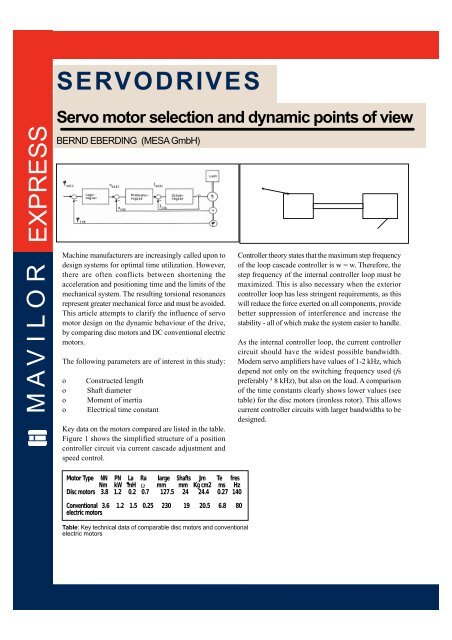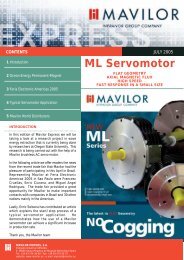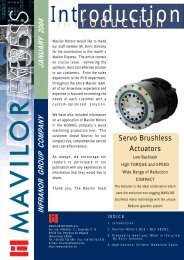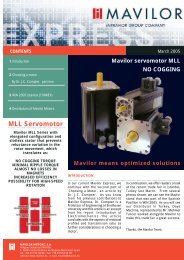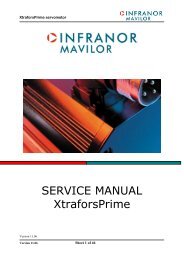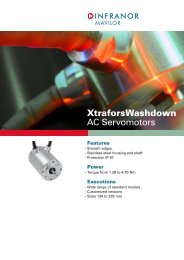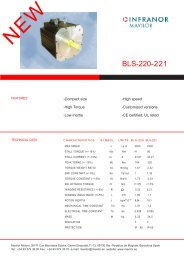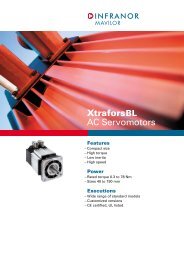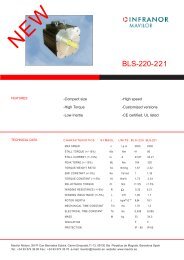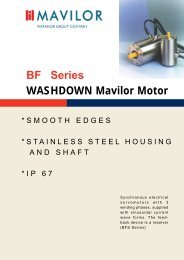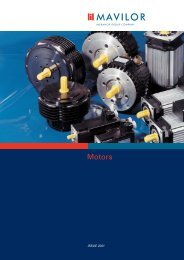Introduction - Mavilor
Introduction - Mavilor
Introduction - Mavilor
You also want an ePaper? Increase the reach of your titles
YUMPU automatically turns print PDFs into web optimized ePapers that Google loves.
SERVODRIVES<br />
M A V I L O R EXPRESS<br />
Servo motor selection and dynamic points of view<br />
BERND EBERDING (MESA GmbH)<br />
Fig.1: Simplified structure of position controller circuit via current cascade<br />
adjustment and speed control.<br />
Machine manufacturers are increasingly called upon to<br />
design systems for optimal time utilization. However,<br />
there are often conflicts between shortening the<br />
acceleration and positioning time and the limits of the<br />
mechanical system. The resulting torsional resonances<br />
represent greater mechanical force and must be avoided.<br />
This article attempts to clarify the influence of servo<br />
motor design on the dynamic behaviour of the drive,<br />
by comparing disc motors and DC conventional electric<br />
motors.<br />
The following parameters are of interest in this study:<br />
o Constructed length<br />
o Shaft diameter<br />
o Moment of inertia<br />
o Electrical time constant<br />
Key data on the motors compared are listed in the table.<br />
Figure 1 shows the simplified structure of a position<br />
controller circuit via current cascade adjustment and<br />
speed control.<br />
mM<br />
Jm<br />
Fig.2: Simplified mechanical structure of a servo motor<br />
Controller theory states that the maximum step frequency<br />
of the loop cascade controller is w = w. Therefore, the<br />
step frequency of the internal controller loop must be<br />
maximized. This is also necessary when the exterior<br />
controller loop has less stringent requirements, as this<br />
will reduce the force exerted on all components, provide<br />
better suppression of interference and increase the<br />
stability - all of which make the system easier to handle.<br />
As the internal controller loop, the current controller<br />
circuit should have the widest possible bandwidth.<br />
Modern servo amplifiers have values of 1-2 kHz, which<br />
depend not only on the switching frequency used (fs<br />
preferably ³ 8 kHz), but also on the load. A comparison<br />
of the time constants clearly shows lower values (see<br />
table) for the disc motors (ironless rotor). This allows<br />
current controller circuits with larger bandwidths to be<br />
designed.<br />
C<br />
Jt<br />
mW<br />
Motor Type NN PN La Ra large Shafts Jm Te fres<br />
Nm kW mH Ω mm mm Kg cm2 ms Hz<br />
Disc motors 3.8 1.2 0.2 0.7 127.5 24 24.4 0.27 140<br />
Conventional 3.6 1.2 1.5 0.25 230 19 20.5 6.8 80<br />
electric motors<br />
Table: Key technical data of comparable disc motors and conventional<br />
electric motors


